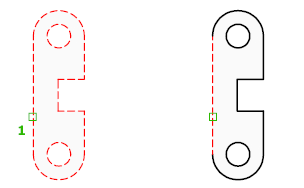Breaks a compound object into its component objects.
Explodes a compound object when you want to modify its components separately. Objects that can be exploded include blocks, polylines, and regions, among others.

The color, linetype, and lineweight of any exploded object might change. Other results differ depending on the type of compound object you're exploding. See the following list of objects that can be exploded and the results for each.
To explode objects and change their properties at the same time, use XPLODE.
Here are the results of EXPLODE for each of the following types of objects:
- 2D Polyline
- 3D Polyline
- 3D Solid
- Annotative Objects
- Arc
- Array
- Block
Removes one grouping level at a time. If a block contains a polyline or a nested block, exploding the block exposes the polyline or nested block object, which must then be exploded to expose its individual objects.
Blocks with equal X, Y, and Z scales explode into their component objects. Blocks with unequal X, Y, and Z scales (nonuniformly scaled blocks) might explode into unexpected objects.
When nonuniformly scaled blocks contain objects that cannot be exploded, they are collected into an anonymous block (named with a “*E” prefix) and referenced with the nonuniform scaling. If all the objects in such a block cannot be exploded, the selected block reference will not be exploded. Body, 3D Solid, and Region entities in a nonuniformly scaled block cannot be exploded. (Not available in AutoCAD LT.)
Exploding a block that contains attributes deletes the attribute values and redisplays the attribute definitions.
Blocks inserted with external references (xrefs) and their dependent blocks cannot be exploded.
Blocks insert with MINSERT cannot be exploded. (MINSERT is not available in AutoCAD LT.)
- Body
- Circle
- Leaders
- Mesh Objects
- Multiline Text
- Multiline
- Polyface Mesh
- Region

